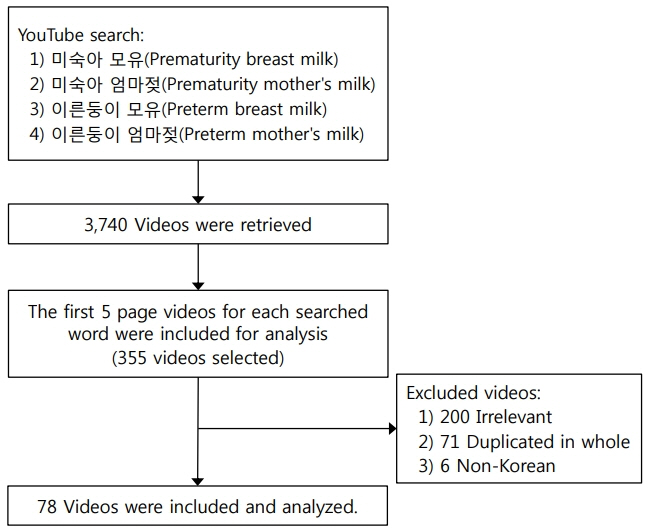Neonatal Med.
2019 Nov;26(4):185-190. 10.5385/nm.2019.26.4.185.
Utility Evaluation of Information from YouTube on Breastfeeding for Preterm Babies
- Affiliations
-
- 1Department of Pediatrics, Dong-A University College of Medicine, Busan, Korea. myojing@dau.ac.kr
- KMID: 2466637
- DOI: http://doi.org/10.5385/nm.2019.26.4.185
Abstract
- PURPOSE
Many studies have reported the merits of breastfeeding, and increasing efforts are made to encourage breastfeeding for preterm babies. Recently, YouTube is being increasingly used as a source of medical information. We evaluated the quality of information provided on YouTube on breastfeeding for preterm babies.
METHODS
On June 20, 2018, we performed a YouTube search using four terms related to breastfeeding for preterm babies. Of the 355 videos in the first five pages, 78 were analyzed; videos with irrelevant content (n=200), duplicated material (n=71), and those using another (non-Korean) language (n=6) were excluded. Videos were classified according to upload source and usefulness, and were evaluated based on reliability and quality.
RESULTS
Medical websites or TV channels (46.2%) and physicians or hospitals (12.8 %) were the most and least common upload sources, respectively. The usefulness of the information was rated the highest in physician or hospital-uploaded videos (70.0%). The reliability of the physician or hospital-uploaded (2.70±1.42) and medical website or TV channel-uploaded (2.91±1.42) videos were statistically significant. The highest proportion of good quality videos (≥good) (60.0%) comprised physician or hospital-uploaded videos. Of the videos evaluated, 44.9% were useful. The highest proportion of useful videos comprised those uploaded by medical websites or TV channels (68.6%). The highest proportion of non-useful videos comprised civilian videos (80.8%).
CONCLUSION
Physician or hospital-uploaded videos were more useful and had excellent reliability and quality; however, these had the least amount of information. Development of educational programs by experts that can be accessed by public through popular platforms like YouTube is necessary.
Keyword
Figure
Reference
-
1. Section on Breastfeeding. Breastfeeding and the use of human milk. Pediatrics. 2012; 129:e827–41.2. Umer A, Hamilton C, Edwards RA, Cottrell L, Giacobbi P Jr, Innes K, et al. Association between breastfeeding and childhood cardiovascular disease risk factors. Matern Child Health J. 2019; 23:228–39.3. Lucas A, Morley R, Cole TJ. Randomised trial of early diet in preterm babies and later intelligence quotient. BMJ. 1998; 317:1481–7.4. Patel AL, Kim JH. Human milk and necrotizing enterocolitis. Semin Pediatr Surg. 2018; 27:34–8.5. Abrahams SW. Milk and social media: online communities and the International Code of Marketing of Breast-milk Substitutes. J Hum Lact. 2012; 28:400–6.6. Gabarron E, Fernandez-Luque L, Armayones M, Lau AY. Identifying measures used for assessing quality of YouTube videos with patient health information: a review of current literature. Interact J Med Res. 2013; 2:e6.7. Singh AG, Singh S, Singh PP. YouTube for information on rheumatoid arthritis: a wakeup call? J Rheumatol. 2012; 39:899–903.8. Delli K, Livas C, Vissink A, Spijkervet FK. Is YouTube useful as a source of information for Sjogren's syndrome? Oral Dis. 2016; 22:196–201.9. Lee JS, Seo HS, Hong TH. YouTube as a source of patient information on gallstone disease. World J Gastroenterol. 2014; 20:4066–70.10. Fat MJ, Doja A, Barrowman N, Sell E. YouTube videos as a teaching tool and patient resource for infantile spasms. J Child Neurol. 2011; 26:804–9.11. Steinberg PL, Wason S, Stern JM, Deters L, Kowal B, Seigne J. YouTube as source of prostate cancer information. Urology. 2010; 75:619–22.12. Liu KY, Haukoos JS, Sasson C. Availability and quality of cardiopulmonary resuscitation information for Spanishspeaking population on the Internet. Resuscitation. 2014; 85:131–7.13. Azer SA, AlOlayan TI, AlGhamdi MA, AlSanea MA. Inflammatory bowel disease: an evaluation of health information on the internet. World J Gastroenterol. 2017; 23:1676–96.14. Bernard A, Langille M, Hughes S, Rose C, Leddin D, Veldhuyzen van Zanten S. A systematic review of patient inflammatory bowel disease information resources on the World Wide Web. Am J Gastroenterol. 2007; 102:2070–7.15. Erdem MN, Karaca S. Evaluating the accuracy and quality of the information in kyphosis videos shared on YouTube. Spine (Phila Pa 1976). 2018; 43:E1334–9.16. Charnock D, Shepperd S, Needham G, Gann R. DISCERN: an instrument for judging the quality of written consumer health information on treatment choices. J Epidemiol Community Health. 1999; 53:105–11.17. Charnock D, Shepperd S. Learning to DISCERN online: applying an appraisal tool to health websites in a workshop setting. Health Educ Res. 2004; 19:440–6.18. Centers for Disease Control and Prevention. Breastfeeding rates [Internet]. Atlanta: CDC;2019. [cited 2019 Nov 6]. Available from: http://www.cdc.gov/breastfeeding/data/NIS_data/.19. Lee WS, Cho J, Choi YS, Chung SH, Bae CW, Jung JA. Breastfeeding rate in below 6 months infants during recent 6-year in Korea based on childcare database. Neonatal Med. 2013; 20:221–7.20. Kang SW. Annual report on live births and deaths statistics. Daejeon: Statistics Korea;2018. Oct. 281. Report No.:11-1240000-000262-10.21. Jang GJ, Lee SL, Kim HM. Breast feeding rates and factors influencing breast feeding practice in late preterm infants: comparison with preterm born at less than 34 weeks of gestational age. J Korean Acad Nurs. 2012; 42:181–9.
- Full Text Links
- Actions
-
Cited
- CITED
-
- Close
- Share
- Similar articles
-
- A Survey on Mothers' Perception of Breastfeeding
- Factors Explaining Mothers' Breastfeeding Satisfaction
- YouTube as an Information Resource for Persons Interested in Septoplasty and/or Turbinoplasty
- Parental Role Stress and Perception of the Newborn in Mothers of Preterm Babies
- Evaluation of YouTube Videos about Isotretinoin as Treatment of Acne Vulgaris




